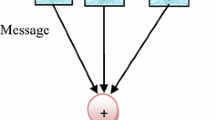Abstract
An efficient coded modulation diversity scheme is proposed to improve the performance of multiple-input-multiple-output orthogonal-frequency-division-multiplexing (MIMO–OFDM) systems in frequency-selective time-varying fading channels. By introducing the rotated modulation and space-time-frequency component interleavers, the proposed scheme globally optimizes powerful forward error correction codes, rotated quadrature amplitude modulation, linear precoding MIMO, and OFDM, thus can achieve modulation diversity and space-time-frequency diversities as much as possible. A simple efficient optimal precoder selection criterion is put forward for this scheme. Based on the analysis of average mutual information, optimal rotation angles are given for different modulation and coding schemes, and the superiority of the proposed scheme is proved. Both software simulation and hardware prototype test results also verify that this new scheme can significantly outperform the conventional bit-interleaved coded modulation scheme under the non-ideal channel estimation, which is up to 4.5 dB signal-to-noise-ratio gain. In a word, the proposed scheme is a simple, efficient and robust transmission technique for the future MIMO–OFDM wireless systems.











Similar content being viewed by others
References
Boutros, J., & Viterbo, E. (1998). Signal space diversity: A power and bandwidth efficient diversity technique for the Rayleigh fadin channel. IEEE Transactions on Information Theory, 44, 1453–1467.
Chindapol, A., & Ritcey, J. A. (1999). Bit-interleaved coded modulation with signal space diversity in Rayleigh fading. In Proceedings of 33rd Asilomar Conference on signals, systems, computers, pp.1003–1007.
Kiyani, N. F., Rizvi, U. H., Weber, J. H., & Janssen, G. J. (2007). Optimized rotations for LDPC-coded MPSK constellations with signal space diversity. In Proceedings of IEEE WCNC, Mar. 2007, pp. 677–681
Kiyani, N. F., & Weber, J. H. (2007). OFDM with BICM-ID and rotated MPSK constellations and signal space diversity. In Proceedings of 14th IEEE symposium on communications and vehicular technology in the Benelux, Nov. 2007, pp. 1–5.
Kiyani, N. F., & Weber, J. H. (2008). EXIT chart analysis of rotated MPSK constellations with BICM-ID, signal space diversity and OFDM. In Proceedings of 15th annual symposium on communications and vehicular technology in the Benelux.
Nour, C. A., & Douillard, C. (2008). Improving BICM performance of QAM constellations for broadcasting applications. In Proceedings of 5th international symposium on turbo codes and related topics, Sept. 2008, pp. 55–60.
Zhanji, W., & Wenbo, W. (2010). A novel joint-coding-modulation-diversity OFDM system. In Proceedings of global mobile congress 2010, Oct. 2010, pp. 307–312.
Zhanji, W., & Wenbo, W. (2012). Improved coding-rotated-modulation orthogonal frequency dividion multiplexing system. IET Communications, 6(3), 272–280.
Vucetic, B., & Yuan, J. (2003). Space–time coding. New York: Wiley.
Foschini, G. (1996). Layered space-time architecture for wireless communication in a fading environment when using multi-element antennas. Bell Labs Technical Journal, 1(2), 41–59.
EI Gamal, H., & Hammons, A. R. (2001). The layered space-time architecture: A new perspective. IEEE Transactions on Information Theory, 47, 2321–2334.
Heath, R. W., Sandhu, S., & Paulraj, A. (2001). Antenna selection for spatial multiplexing systems with linear receivers. IEEE Communications Letters, 5(4), 142–144.
Love, D. J., & Heath, R. W. (2005). Limited feedback unitary precoding for spatial multiplexing systems. IEEE Transactions on Information Theory, 51(8), 2967–2976.
3GPP TS 36.212 v8.5.0, 3rd Generation Partnership Project; Technical Specification Group Radio Access Network; Evolved Universal Terrestrial Radio Access (E-UTRA);Multiplexing and channel coding (Release 8), pp. 12–18, December 2008.
3GPP TS 36.211 v10.2.0, 3rd Generation Partnership Project; Technical Specification Group Radio Access Network; Evolved Universal Terrestrial Radio Access (E-UTRA); Multiplexing and channel coding (Release 10), pp. 44–50, December 2010.
IEEE Std802.11n-2009, 2009.
Caire, G., Taricco, G., & Biglieri, E. (1998). Bit-interleaved coded modulation. IEEE Transactions on Information Theory, 44(3), 927–946.
Xie, Q., Song, J., Peng, K., et al. (2011). Coded modulation with signal space diversity. IEEE Transactions on Wireless Communications, 10(2), 660–668.
Goff, S. Y. (2003). Signal constellation for bit-interleavedcoded modulation. IEEE Transactions on Information Theory, 49(1), 307–313.
3GPP TS 25.943,V10.0.0.3rd Generation Partnership Project (3GPP), Technical Specification Group Radio Access Network, Deployment aspects (Release 10), 2011.4.
Report ITU-R M.2135-1, Guidelines for evaluation of radio interface technologies for IMT-Advanced, Dec. 2009.
Liu, W., Wu, Z., & Jin, H. (2011). An enhanced LMMSE channel estimation method for OFDM systems with virtual subcarriers, in Proceedings of IET international conference on communication technology and application (ICCTA 2011), pp. 171–175.
Zhanji, W., & Wenbo, W. (2008). Efficient difference-based decoding implementations of LDPC codes. IEEE Communications Letters, 12(5), 383–385.
Zhanji, W., & Wenbo, W. (2008). A new parity-check stopping criterion for Turbo decoding. IEEE Communications Letters, 12(4), 304–306.
Zhou, W., & Lam, W. H. (2009). A fast LMMSE channel estimation method for OFDM systems. EURASIP Journal on Wireless Communications and Networking, 2009, 1–13.
Acknowledgments
This work is sponsored by the National Natural Science Fund (61171101), the Fundamental Research Funds for the Central Universities and 2014 Doctorial Innovation Fund of BUPT (CX201426).
Author information
Authors and Affiliations
Corresponding author
Additional information
X. Gao contributed equally to this article.
Appendix: Proof of Equation (16)
Appendix: Proof of Equation (16)
Proof
For the MIMO detection, after the phase-compensation operation in the Eq. (12), the reference complex signal of \(\left( b_t^I,b_t^Q\right) \) is shown as the following:
where, according to the Eq. (6), \(g_t^i = {a_{ii}} \cdot x_t^i\), and \(x_t^i\) is the transmit rotated modulation symbol.
Thus, \(REF_t^i = \frac{{{a_{ii}} \cdot a_{ii}^*}}{{{{\left| {{a_{ii}}} \right| }^2}}}x_t^i = x_t^i\), that is to say, the received reference signal is the same as the transmit rotated signal.
According to the Eq. (12), the variance of the interference and noise \(VAR(b_t^i - {x_j})\) is calculated as the following:
According to the Eq. (8),
Thus, the variance of the interference and noise is shown as the following:
According to the Eq. (9), it is easy to know
That is to say, the variance is the reciprocal of SINR. Thus, the metric \(E_{i,j}\) is computed as the following:
Rights and permissions
About this article
Cite this article
Wu, Z., Gao, X. An Efficient Practical MIMO–OFDM Scheme with Coded Modulation Diversity for Future Wireless Communications. Wireless Pers Commun 91, 487–508 (2016). https://doi.org/10.1007/s11277-016-3472-9
Published:
Issue Date:
DOI: https://doi.org/10.1007/s11277-016-3472-9




